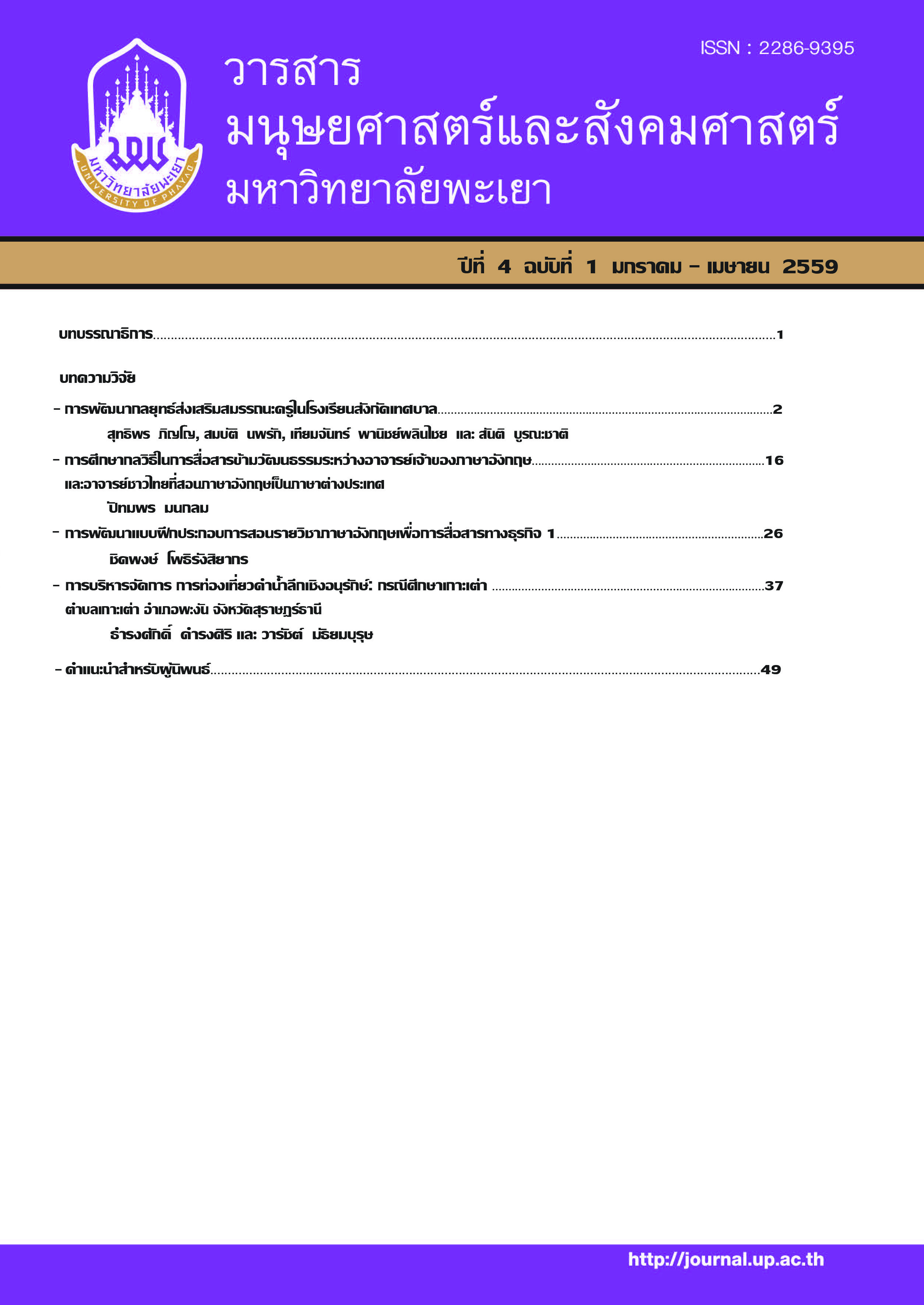The Development of Teaching Exercises of English for Business Communication 1
Keywords:
Teaching Exercises of English for Business Communication 1, AchievementAbstract
This research aimed to develop teaching exercises of English for Business Communication 1. The participants in this study were the 233 (the normal students of the second semester, year 2014) and 169 (the AEC students of the first semester, year 2015, and the normal students of the second semester, year 2015) students of the University of Phayao who enrolled in this subject (146271 [1] English for business communication 1). The tools for this research were exercises related with contents taught in the classroom including Pre-Test and Post-Test, and the questionnaire. The data was analyzed for finding achievement.
The findings showed that most of the participants got higher score after doing Post-Test. In addition, this research included questionnaire for finding satisfaction of main contents and conversations with examples, and the additional contents for effective business. The overall image showed that level 4 was ranked the first, level 5 was ranked the second, level 2 was ranked the third, and level 1 was ranked the fourth. In the case of commentary results from the participants, the should be reduced contents, the should be prepared pre-studying documents, the should be added up examples and activities, the should be added up figures and conversations, and the should be highlighted resume (CV), business and cover letter, and fax were showed respectively.
References
กิดานันท์ มลิทอง. (2540). เทคโนโลยีทางการศึกษาและนวัตกรรม. กรุงเทพฯ: จุฬาลงกรณ์มหาวิทยาลัย.
บัญชา อึ๋งสกุล. (2545). การพัฒนากระบวนการเรียนรู้ภาษาอังกฤษ: หลักการ ทักษะและการปฏิบัติการ.
ประชุมพร สุวรรณตรา. (2523). การเขียนแบบสร้างสรรค์. ขอนแก่น: ภาควิชาการประถมศึกษา คณะศึกษาศาสตร์ มหาวิทยาลัยขอนแก่น.
ภัทรศักดิ โอสถานุเคราะห์. (2548). ทำไมเมืองไทยจึงไร้มาตรฐานทางภาษาต่างชาติ. กรุงเทพฯ: อนิตพับบลิชชิงการพิมพ์.
ยุพาภรณ์ ชาวเชียงขวาง. (2537). การเปรียบเทียบผลสัมฤทธิ์ทางการเขียนเรียงความโดยใช้แบบฝึกทักษะการเขียนเรียงความกับการสอนปกติชั้นประถมศึกษาปีที่ 6 โรงเรียนชุมชนบ้านเชียงบาน อำเภอเชียงคํา จังหวัดพะเยา. ปริญญานิพนธ์การศึกษามหาบัณฑิตสาขาวิชาการประถมศึกษาบัณฑิตวิทยาลัยมหาวิทยาลัยศรีนครินทรวิโรฒประสานมิตร. กรุงเทพฯ.
วนิดา เพ็ญกิ่งกาญจน์. (ม.ป.ป.). (2531). เทคนิคการสอนเขียนภาษาอังกฤษในระดับมัธยมศึกษา. ภาควิชามัธยมศึกษา คณะศึกษาศาสตร์ มหาวิทยาลัยเชียงใหม่. เชียงใหม่.
วนิดา สุขวนิช. (2536). การใช้แบบฝึกเพื่อพัฒนาความรู้ความเข้าใจหลักเกณฑ์ทางภาษาของนักเรียนชั้นประถมศึกษาปีที่ 4 เกี่ยวกับการอ่านและเขียนคำควบกล้ำ อักษรนํา และตัวการันต์. การวิจัยทางการศึกษา 23, 2; หน้า 33-44.
สุโชติ ดาวสุโข และ สาโรจน์ แพ่งยัง. (2535). คู่มือการสอน. กรุงเทพฯ: คณะกรรมการฝ่ายส่งเสริมการผลิตตำราและสื่อการสอน มหาวิทยาลัยเกษตรศาสตร์.
อดุลย์ วิริยะเดชกุล. (2540). คู่มือจัดการเรียนการสอนระดับบัณฑิตศึกษา. บัณฑิตวิทยาลัย มหาวิทยาลัยมหิดล. นครปฐม; หน้า 52-66.
Bock, Susanne. (1993). Developing Materials for the Study of Literature. English Teaching Forum 31, 3, p. 2-4.
Breen, Michael P. (1987). Learner contribution to task design. In Language learning tasks. Englewood Cliffs: Prentice-Hall International Ltd and Lancaster University; p. 28-46.
Cronin, J. (1995). A graduate communication course for an era of global commerce: a case study. Business Communication Quarterly, 58; p. 32-39.
Dudley-Evans, T., St John, M. J. (1998). Development in English for specific purposes: a multi-disciplinary approach. Cambridge University Press.
Ribe, Ramanand and Nuria Vidal. (1993). Project work. Oxford: Hainemann; p. 82-90.
Richards et al. (1986). Approaches and methods in language teaching. Cambridge: Cambridge University Press.
Shand, Coral Jean. (2002). Primary school teachers integrate electronic storybook software into their teaching / learning practices through addressing issues of pedagogy, organization and management. M.Ed. (Admin). Sydney: University of Western Sydney; 2002..
Downloads
Published
How to Cite
Issue
Section
License
ผู้นิพนธ์ต้องรับผิดชอบข้อความในบทนิพนธ์ของตน มหาวิทยาลัยพะเยาไม่จำเป็นต้องเห็นด้วยกับบทความที่ตีพิมพ์เสมอไป ผู้สนใจสามารถคัดลอก และนำไปใช้ได้ แต่จะต้องขออนุมัติเจ้าของ และได้รับการอนุมัติเป็นลายลักษณ์อักษรก่อน พร้อมกับมีการอ้างอิงและกล่าวคำขอบคุณให้ถูกต้องด้วย
The authors are themselves responsible for their contents. Signed articles may not always reflect the opinion of University of Phayao. The articles can be reproduced and reprinted, provided that permission is given by the authors and acknowledgement must be given.







